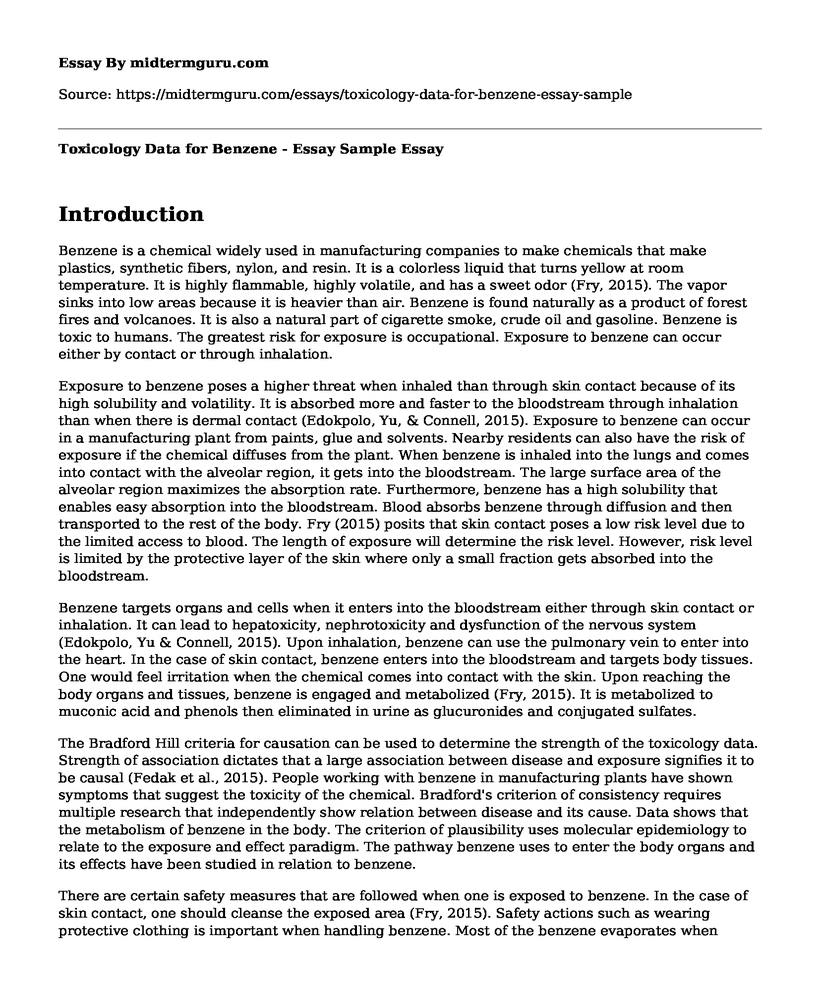Introduction
Benzene is a chemical widely used in manufacturing companies to make chemicals that make plastics, synthetic fibers, nylon, and resin. It is a colorless liquid that turns yellow at room temperature. It is highly flammable, highly volatile, and has a sweet odor (Fry, 2015). The vapor sinks into low areas because it is heavier than air. Benzene is found naturally as a product of forest fires and volcanoes. It is also a natural part of cigarette smoke, crude oil and gasoline. Benzene is toxic to humans. The greatest risk for exposure is occupational. Exposure to benzene can occur either by contact or through inhalation.
Exposure to benzene poses a higher threat when inhaled than through skin contact because of its high solubility and volatility. It is absorbed more and faster to the bloodstream through inhalation than when there is dermal contact (Edokpolo, Yu, & Connell, 2015). Exposure to benzene can occur in a manufacturing plant from paints, glue and solvents. Nearby residents can also have the risk of exposure if the chemical diffuses from the plant. When benzene is inhaled into the lungs and comes into contact with the alveolar region, it gets into the bloodstream. The large surface area of the alveolar region maximizes the absorption rate. Furthermore, benzene has a high solubility that enables easy absorption into the bloodstream. Blood absorbs benzene through diffusion and then transported to the rest of the body. Fry (2015) posits that skin contact poses a low risk level due to the limited access to blood. The length of exposure will determine the risk level. However, risk level is limited by the protective layer of the skin where only a small fraction gets absorbed into the bloodstream.
Benzene targets organs and cells when it enters into the bloodstream either through skin contact or inhalation. It can lead to hepatoxicity, nephrotoxicity and dysfunction of the nervous system (Edokpolo, Yu & Connell, 2015). Upon inhalation, benzene can use the pulmonary vein to enter into the heart. In the case of skin contact, benzene enters into the bloodstream and targets body tissues. One would feel irritation when the chemical comes into contact with the skin. Upon reaching the body organs and tissues, benzene is engaged and metabolized (Fry, 2015). It is metabolized to muconic acid and phenols then eliminated in urine as glucuronides and conjugated sulfates.
The Bradford Hill criteria for causation can be used to determine the strength of the toxicology data. Strength of association dictates that a large association between disease and exposure signifies it to be causal (Fedak et al., 2015). People working with benzene in manufacturing plants have shown symptoms that suggest the toxicity of the chemical. Bradford's criterion of consistency requires multiple research that independently show relation between disease and its cause. Data shows that the metabolism of benzene in the body. The criterion of plausibility uses molecular epidemiology to relate to the exposure and effect paradigm. The pathway benzene uses to enter the body organs and its effects have been studied in relation to benzene.
There are certain safety measures that are followed when one is exposed to benzene. In the case of skin contact, one should cleanse the exposed area (Fry, 2015). Safety actions such as wearing protective clothing is important when handling benzene. Most of the benzene evaporates when exposed to the skin, and cleaning the area will reduce the health risk. Exposure to benzene has immediate effects where one would have pale skin, experience headache, difficulty in breathing, and if prolonged, death. Skin contacts hold be rinsed with water to prevent it from getting through to the bloodstream. First aid after exposure to benzene through inhalation should involve taking one out to receive fresh air (Edokpolo, Yu & Connell, 2015). Emergency services should be contacted thereafter with the details of the exposure.
Benzene has industrial applications but it is harmful to humans. People working in industries that use or make benzene are the greatest risk of exposure. The chemical alters body functions such as it can limit the production of red blood cells that leads to anemia. It can also modify the functions of white blood cells and antibodies leading to dysfunction of the immune system. The severity of its effects is dependent on the length of exposure. One should move to an area with fresh air if there is benzene is released into air. Clothing exposed to benzene should also be removed immediately without taking it over the head and then disposed. Washing clothes and oneself should follow. There is no existing antidote for benzene exposure, but seeking medical care can alleviate symptoms.
References
Edokpolo, B., Yu, Q. J., & Connell, D. (2015). Health Risk Assessment for Exposure to Benzene in Petroleum Refinery Environment. Int. J. Environ. Res. Public Health, 12, 595-61.
Fedak, K. M., et al. (2015). Applying the Bradford Hill criteria in the 21st century: how data integration has changed causal inference in molecular epidemiology. Emerging Themes in Epidemiology, 12:14.
Fry, R. C. (2015). Systems biology in toxicology and environmental health. London, England: Academic Pres.
Cite this page
Toxicology Data for Benzene - Essay Sample. (2022, Nov 07). Retrieved from https://midtermguru.com/essays/toxicology-data-for-benzene-essay-sample
If you are the original author of this essay and no longer wish to have it published on the midtermguru.com website, please click below to request its removal:
- Analytical Chemist Applying for the Post of Laboratory Specialist for Antibiotics Discovery Project
- Analyze Groundwater Sustainability With Human Population Growth - Paper Example
- Paper Example on Organic Chemistry and Its Differences from Other Branches of Chemistry
- Paper Example on Primate Intelligence Evolution
- Exploring the Physical Geography and Societal Relationships of Papua New Guinea in Oceania - Essay Sample
- Environmental Pollution: A Critical Threat to Human & Planet - Research Paper
- Human Agency in Anthropology: Free Agent or Social Structure? - Essay Sample







